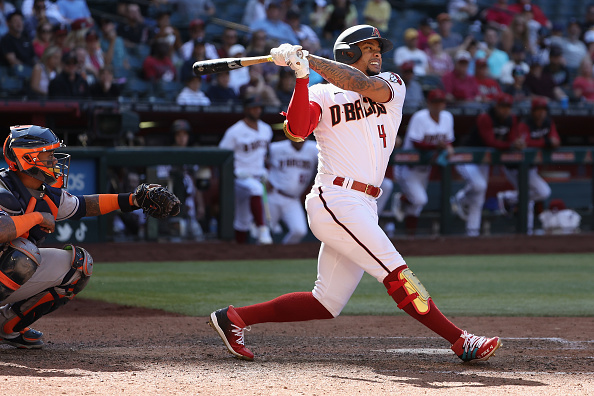Diamondbacks Hitting Woes Run Deeper than You Realize
The Arizona Diamondbacks have started the season 3–6, last in the National League West. Pitching, for the most part, has not been the problem. It has been a lack of timely hitting. There are goods and bads to what is happening. Their approach is excellent, forcing opposing pitchers to throw strikes. However, when strikes are thrown, the Diamondbacks are not capitalizing. A look at the Diamondbacks hitting splits tells the full story.
Diamondbacks Hitting: Overall Stats
Overall batting stats show that the Diamondbacks are not doing well, to say the least. A positive is that they lead the league in walk percentage, with 14%. That is almost three full percentage points ahead of the second-place New York Mets. Again, it shows that the Diamondbacks are taking good approaches at the plate. However, unless a team draws several walks in a row, the walks only translate to runs if hits come afterwards. That has been a big problem for the Diamondbacks, because their batting average is .152 — dead last in the National League. To put that in perspective, six Diamondbacks pitchers batted better than .152 in 2021.
Their slash line — .152/.284/.264 — shows another problem: their on-base percentage is higher than their slugging percentage. When hitting is in proper balance, the first digit of each slash number will generally increase by one. If a team’s batting average is in the .200s, then their on-base percentage will be in the .300s and their slugging percentage will be in the .400s. The Colorado Rockies, St. Louis Cardinals, Chicago Cubs, Philadelphia Phillies, New York Mets, San Francisco Giants, and Los Angeles Dodgers are all currently doing that. If a team’s on-base percentage and slugging percentage both start with the same number, that means they’re not getting enough extra-base hits. It is even worse for the Diamondbacks, however, because their on-base percentage is higher than their slugging percentage. Not only is this alarming, but no other team in the National League is doing so.
Low Run Production
These two factors merely scratch the surface when looking at their abysmal run production thus far in the season. When looking at their overall offensive performance — measured by weighted runs above average (wRAA) — the Diamondbacks come in nearly 12 runs below the league average. The only team with a lower wRAA score is the Cincinnati Reds. That is because the Reds have drawn slightly more than half the walks that the Diamondbacks have, doing so while playing one more game.
But it gets worse than that for the Diamondbacks. They hit much better with the bases empty than they do with runners on base or in scoring position, as seen in the tables below. Take for example, their extra-base hits. They have a total of 17 extra-base hits on the season. Ten of them have come with the bases empty, while seven of them have come with runners on base. Of those seven, only three have come with runners in scoring position. Look also at their home runs. The Diamondbacks have a total of seven home runs on the season. Four were solo shots.
Runs Per Hit
Using linear regression, statisticians have discovered how many runs, on average, each type of hit is worth. They also have figured out the same for walks and for hit batsmen. This writing is not the place to explain how linear regression works (look it up), but we can discuss the results. Here is a table showing roughly how many runs 10 walks, 10 HBP, and 10 of each type of hit are worth. This table shows even more conclusively that in order for walks to fully pay off, a team must get hits — especially extra-base hits — afterwards.
| 10 walks = 7 Runs |
| 10 hit batsmen = 7 Runs |
| 10 singles = 9 Runs |
| 10 doubles = 13 Runs |
| 10 triples = 16 Runs |
| 10 home runs = 21 Runs |
Each extra-base hit is worth more than one run, on average, for multiple reasons. The first reason may seem obvious — home runs automatically score the batter as well as all runners. The other reasons apply to doubles and triples. If the extra-base hit comes with a runner on base, said runner scores more than half the time. Furthermore, the player who hit the extra-base hit immediately puts himself in scoring position, increasing the chances that a teammate will later drive him in.
Diamondbacks Hitting: Outlook
Clearly the Diamondbacks hitting must improve in order to score more runs. There are several possible explanations as to why they have started so slowly. It is quite possible that their schedule has played into it. The San Diego Padres and New York Mets have two of the strongest pitching rotations in all of Major League Baseball. Seven of the Diamondbacks’ nine games have been against these two teams. While this may be an explanation, the Diamondbacks coaching staff will not use it as an excuse. No player will do so either. Everyone in that clubhouse both wants and expects to perform better than they currently are.
They eventually will do better. It all comes out in the wash, as the old saying goes, and the players are, almost to a man, performing below their career averages. While it is possible that some players have declined, it is still too early to tell. Regardless of the reason for the low performance, the results are clear. To win more games, they must score more runs. The only way to do that is to get more hits, especially with runners on base and, more importantly, in scoring position.
Diamondbacks Hitting: Individual Splits
* = left-handed hitter; (R) = rookie; # = switch-hitter; italics = player is now in minors.






